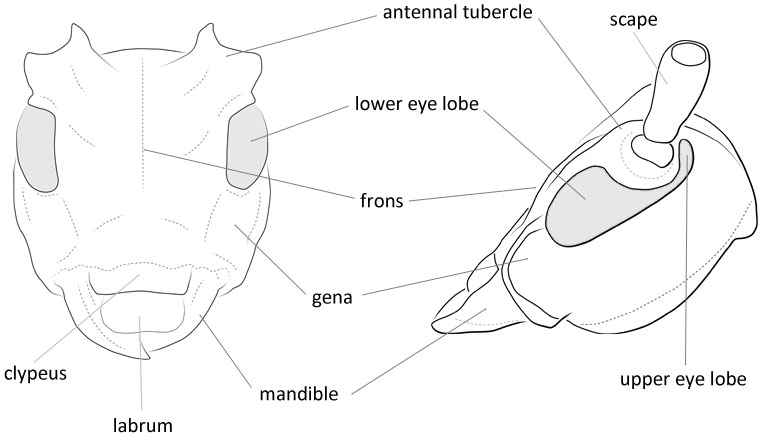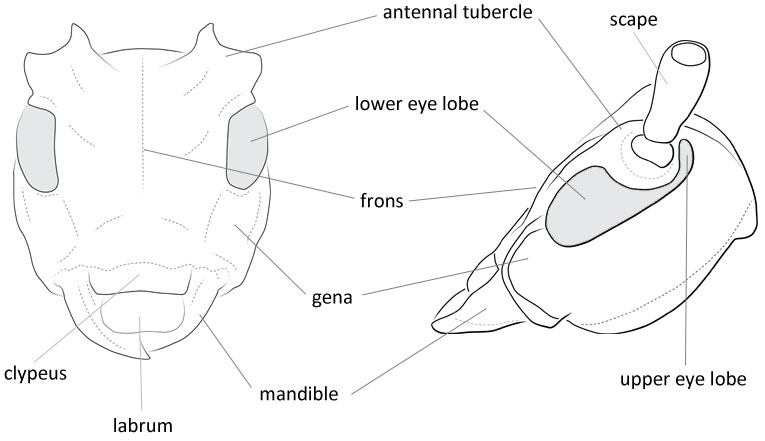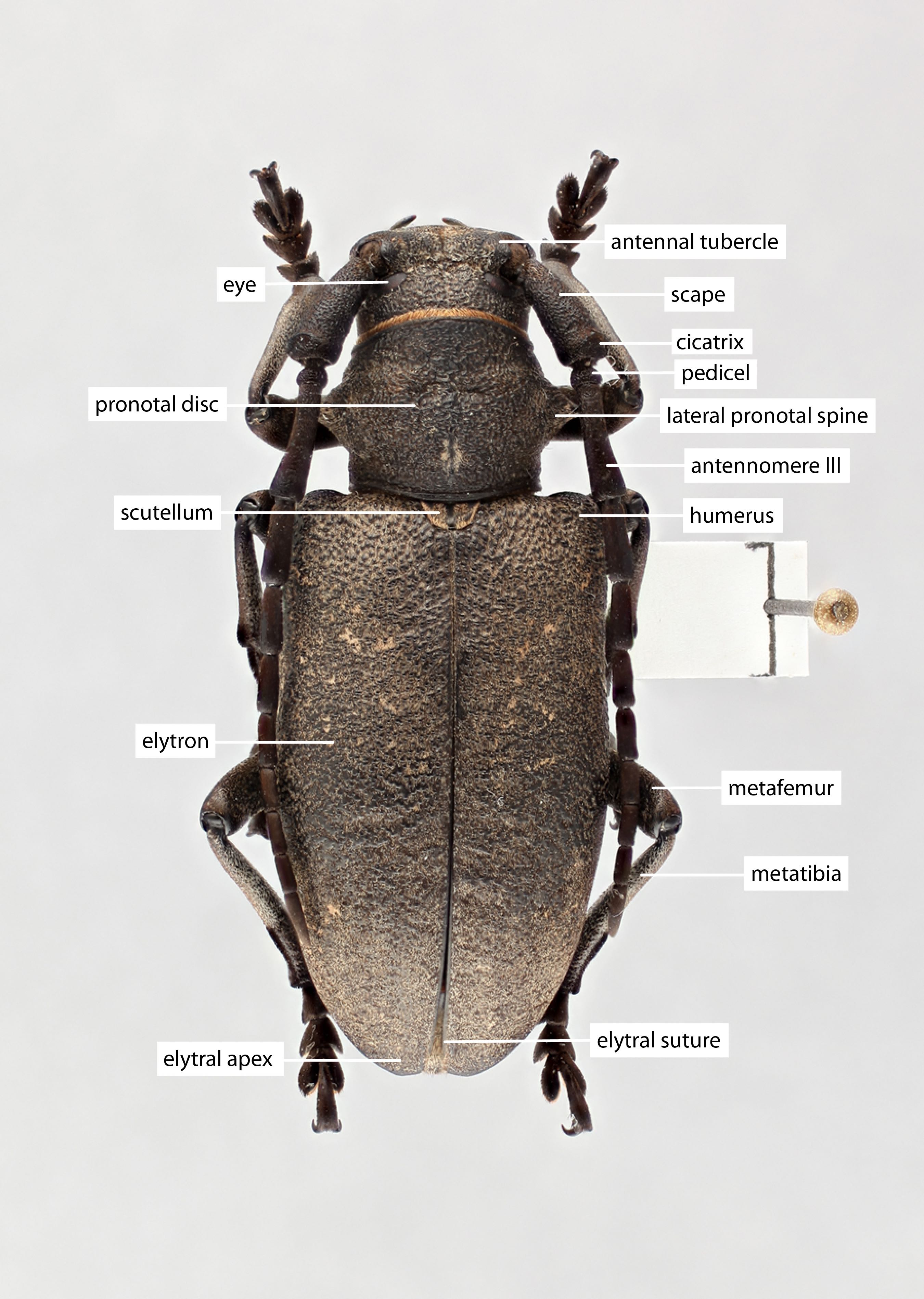Monohammus saltuarius Gebler, 1830: 184
Length: 11–20 mm.
Elytral length:width ratio: length > 2x width or length < 2x width.
Face: shape wide rectangle; genagena:
the part of the cranium on each side below the eye length shorter than lower eye lobeeye lobe:
length shorter than lower eye lobeeye lobe:
used to refer to the upper or lower portion when the eye is emarginate or separated or subequal to lower eye lobeeye lobe:
or subequal to lower eye lobeeye lobe:
used to refer to the upper or lower portion when the eye is emarginate or separated .
.
Pronotum:pronotum:
the upper and dorsal part of the prothorax
dense setaeseta:
a sclerotized hair-like projection of the cuticle
on dorsum of lateral spines present or absent; maculaemacula:
a spot or mark
on pronotal disk: 2–4 dots present; posteromedial tubercletubercle:
a small knoblike or rounded protuberance
absent; lateral erect setaeseta:
a sclerotized hair-like projection of the cuticle
: only present posterior to spinespine:
a protuberance with an acute (sharp) distal end
.
Scutellum:scutellum:
a small sclerite located directly posterior to the pronotum, bordered laterally by the elytra pubescence broken at least partially along midline.
pubescence broken at least partially along midline.
Elytra:elytron:
the leathery forewing of beetles, serving as a covering for the hind wings, commonly meeting opposite elytron in a straight line down the middle of the dorsum in repose
elytral integument color black; elytral maculaemacula:
a spot or mark
: pubescence forming horizontal band(s), many small circular spots or sparse ash-like pubescence; elytral sutural apexapex:
end of any structure distad to the base
rounded; elevation in basal third followed by impression absent; basal granulation dense and smooth; middle to apical punctationpunctation:
pits or depression of variable size in cuticle
fine.
Antennal length (female): >3.5 segments beyond elytral apexapex:
end of any structure distad to the base
.
Aedeagus:aedeagus:
in male beetles, the penis
paramereparamere:
A pair of finger-like structures that are located where the male genitalia exits the abdomen.
mediobasal tooth present; apical tip (ventral view) slightly rounded; terminal segment absent; scleritesclerite:
any hardened plate of the body wall bounded by membrane or sutures; sometimes found floating in the internal sac of male genitalia
in internal sac absent.
In sculpture of elytraelytron:
the leathery forewing of beetles, serving as a covering for the hind wings, commonly meeting opposite elytron in a straight line down the middle of the dorsum in repose
closer to M. impluviatus Motsch., but well distinguished from it by much longer antennaeantenna:
in larval and adult insects, paired segmented appendages, borne one on each side of the head, functioning as sense organs and bearing a large number of sensilla
, and from other species distinguished by coarse punctationpunctation:
pits or depression of variable size in cuticle
only at basebase:
the part of any appendage or structure that is nearest the body
of elytraelytron:
the leathery forewing of beetles, serving as a covering for the hind wings, commonly meeting opposite elytron in a straight line down the middle of the dorsum in repose
. Head with minute compact rugoserugose:
wrinkled
punctation and yellowish-gray adherent hairs, very narrow median longitudinal groove, inner to basebase:
the part of any appendage or structure that is nearest the body
of antennaeantenna:
in larval and adult insects, paired segmented appendages, borne one on each side of the head, functioning as sense organs and bearing a large number of sensilla
with more or less produced, finely punctatepunctate:
set with fine, impressed points or punctures appearing as pin-pricks
tubercletubercle:
a small knoblike or rounded protuberance
, sinciput medially between upper ocular lobes with barely perceptible, yellowish, slightly translucent spotlet. Eyes finely faceted, broadly emarginateemarginate:
notched at the margin . Antennaeantenna:
. Antennaeantenna:
in larval and adult insects, paired segmented appendages, borne one on each side of the head, functioning as sense organs and bearing a large number of sensilla
extending beyond apexapex:
end of any structure distad to the base
of elytraelytron:
the leathery forewing of beetles, serving as a covering for the hind wings, commonly meeting opposite elytron in a straight line down the middle of the dorsum in repose
by 8th (female) or 6th (male) segment, with thin simple (female) or granular shagreen (male) punctationpunctation:
pits or depression of variable size in cuticle
; segments basally with broad whitish pilose ringlet (female) or without it (male). Pronotumpronotum:
the upper and dorsal part of the prothorax
transversetransverse:
broader than long
(female) or almost oblongoblong:
longer than broad
(male), in anterior third and near basebase:
the part of any appendage or structure that is nearest the body
with broad flange, laterally with large conicalconical:
wider at base than apex
, sometimes more extended tubercletubercle:
a small knoblike or rounded protuberance
, disk convex, with dense rugoserugose:
wrinkled
punctation, on flange with thin transversetransverse:
broader than long
striae, with yellowish adherent hairs forming two spots on fore- and hind disc, one spot near basebase:
the part of any appendage or structure that is nearest the body
of each lateral tubercletubercle:
a small knoblike or rounded protuberance
(anterior spots always more, posterior spots less distinct). Pronotal shield flat, posteriorly broadly rounded, with dense, somewhat rusty hairs, medially with glabrousglabrous:
smooth, devoid of pubescence; devoid of any sculpturing
longitudinal band or without it (in which case, entire shield densely pilose). Elytraelytron:
the leathery forewing of beetles, serving as a covering for the hind wings, commonly meeting opposite elytron in a straight line down the middle of the dorsum in repose
parallel-sided (male) or from basebase:
the part of any appendage or structure that is nearest the body
slightly enlarged posteriorly (female), apically separately rounded, sloping at outer angles more, at inner less, disk convex, basally with coarse flat, transversely extended punctationpunctation:
pits or depression of variable size in cuticle
, in remaining part with fine sparse punctures, with short, compact adherent brownish and bright yellowish-gray or white hairs forming on common brownish background bright grayish or yellowish-gray spots, with well-manifest tendency toward formation of broad transversetransverse:
broader than long
band medially. Forelegs of males not longer than midlegs, midtibiae on outer side with gentle distaldistal:
near or toward the free end of any appendage; that part of a segment farthest from the body
notch bearing short brownish bristles forming compact brush. Body ventrally with short yellowish-gray adherent and long thin semierect hairs. Abdominal sternite V short, apically emarginateemarginate:
notched at the margin , at posterior angles with long dense hairs forming cluster on each side (female) or rounded, with uniform brownish bristles (male). Body, antennaeantenna:
, at posterior angles with long dense hairs forming cluster on each side (female) or rounded, with uniform brownish bristles (male). Body, antennaeantenna:
in larval and adult insects, paired segmented appendages, borne one on each side of the head, functioning as sense organs and bearing a large number of sensilla
, elytraelytron:
the leathery forewing of beetles, serving as a covering for the hind wings, commonly meeting opposite elytron in a straight line down the middle of the dorsum in repose
, and legs black. Body length 13–19 mm. (Cherepanov 1990Cherepanov 1990:
Cherepanov AI. 1990. Cerambycidae of Northern Asia, Vol. 3. Lamiinae, Part I. Oxonian Press, New Delhi 4: i–xiii + 1–300, 120 figs.)
M. impluviatus, M. scutellatus, M. sutor
M. saltuarius has a more elongateelongate:
much longer than wide
body with shining elytraelytron:
the leathery forewing of beetles, serving as a covering for the hind wings, commonly meeting opposite elytron in a straight line down the middle of the dorsum in repose
and usually a loosely defined transversetransverse:
broader than long
band. The male genitalia lacks a scleritesclerite:
any hardened plate of the body wall bounded by membrane or sutures; sometimes found floating in the internal sac of male genitalia
.
from Europe to eastern Russia and Korea
Abies, Larix, Picea, Pinus, Tsuga (Titan DatabaseTitan Database:
Tavakilian GL and Chevillotte H. 2022. Titan: base de données internationales sur les Cerambycidae ou Longicornes. Version 3.0. Available from: http://titan.gbif.fr/ last accessed September 2022)
The subspecies M. s. occidentalis is of doubtful status as a good taxon, and its description does not seem to take into account the diversity present across geography.
Monochamus saltuarius occidentalis Sláma, 2017: 934